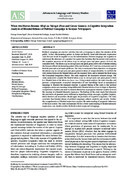| dc.contributor.author | Ogal, George Ouma | |
| dc.contributor.author | Gathigia, Moses Gatambuki | |
| dc.contributor.author | Maitaria, Joseph Nyehita | |
| dc.date.accessioned | 2020-01-22T08:03:28Z | |
| dc.date.available | 2020-01-22T08:03:28Z | |
| dc.date.issued | 2019-07 | |
| dc.identifier.citation | ALLS 10(4):21-27 | en_US |
| dc.identifier.issn | 2203-4714 | |
| dc.identifier.uri | https://karuspace.karu.ac.ke/handle/20.500.12092/2379 | |
| dc.description.abstract | Political campaigns are emotive activities that rely on language to attract the attention of the public. In fact, electioneering periods in Kenya are heavily laced with idiomatic expressions such that one would be required to use the interrelatedness between language and cognition to understand the utterances of a speaker. It is against this backdrop that the present study analyzes
the cognitive processes of the idiom minji na ndengũ (peas and green grams) vis-à-vis the canonized form. The idiom minji na ndengũ (peas and green grams) drew a lot of attention during the Kenyan official electioneering period (May and October, 2017) and was extensively used in both the print and social media platforms. The study is anchored in three objectives: to categorize
the idiom minji na ndengũ (peas and green grams) in terms of compositionality; to establish the vital relation between the blended idiom and the canonical form; and to interpret the blend using the Conceptual Integration Theory. The study employed the descriptive research design. The study purposively sampled the blended idiom minji na ndengũ (peas and green grams) which
is a blended form of the idiom two horse race. Using content analysis, the study classifies and presents a diagrammatic conceptual interpretation of new knowledge based on metaphorical mappings to illustrate the emergent structure. A general finding of this study is that political campaigns create new meanings using deliberately blended idioms of war to improve figurative
competencies. Further, one needs to immerse themselves in pragmatic inference in order to reveal the meaning of a blended idiomatic expression. The findings of this study imply that whenever the provisions of grammar prove deficient in unpacking certain messages, cognitive linguists, idiom theorists and researchers should apply the postulates of Cognitive Linguistics. The study concludes that blended idioms of political campaigns achieve creativity and novelty. Further, the comprehension of blended expressions requires the understanding of pragmatic inferences of the local context. The study recommends that for a better understanding of blended idiomatic expressions, one should consider the local contexts expressed in language. | en_US |
| dc.language.iso | en | en_US |
| dc.publisher | Advances in Language and Literary Studies | en_US |
| dc.subject | Blended Idioms | en_US |
| dc.subject | Mental Spaces, | en_US |
| dc.subject | Minji Na Ndengũ, | en_US |
| dc.subject | Political Campaigns, | en_US |
| dc.subject | Conceptual Integration Theory | en_US |
| dc.subject | Metaphorical Mappings, | en_US |
| dc.subject | Vital Relations | en_US |
| dc.title | When two Horses Become Minji na Ndengũ (Peas and Green Grams): A Cognitive Integration Analysis of Blended Idioms of Political Campaign in Kenyan Newspapers | en_US |
| dc.type | Article | en_US |
